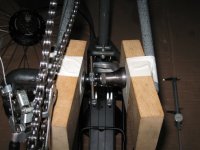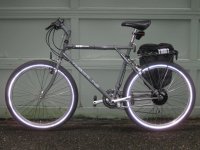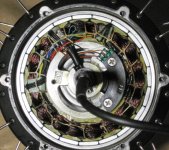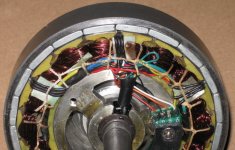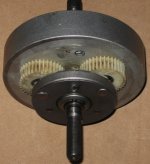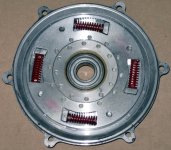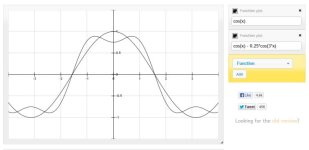WhatcomRider
100 W
After reading up on the advantages of sine-wave controllers I was curious if any Chinese vendors are currently supplying them. A search on AliExpress turned up store no. 323339 (http://www.aliexpress.com/store/323339) that lists 12 e-bike conversion kits - some with integrated torque-sensor motors and/or sine-wave controllers - all designed for the European market. I was intrigued, so I initiated what turned out to be a lengthy email exchange with the store manager Yonggang Lu of Suzhou Minshine Electronics Co. I was interested in the 36V kit with all the goodies @ USD305. I asked for a higher speed motor to reach 18-20 mph and he was willing to part with a 280 rpm wind (e.q. 310 no-load rpm). I kept negotiating shipping costs down until Yonggang found a shipping company called JCEX that would ship the kit (less wheel) to the USA for USD98. Turned out that as a resident of WA state I couldn't purchase the kit through AliExpress due to some ongoing litigation with the state. I wasn't about to wire the money without some kind of protection, so Yonggang finally offered to ship the kit risk-free and I couldn't refuse.
Last week the kit was shipped in the wee hours of Wednesday morning and arrived at my doorstep on Friday afternoon, a total of 2 1/2 days! Turned out JCEX handed the package over to Fedex Express in China upon which it was flown directly to Seattle and then loaded onto a Fedex truck heading north. The components were packed securely so that nothing was damaged. This is what I received (click to enlarge):
View attachment 1
Yonggang supplied the samples shown in the lower left - 2 different display units and a regular controller.
I have the kit hooked up on my kitchen table test bench, powered by my Ultramotor Europa 36V battery, and undergoing initial testing:
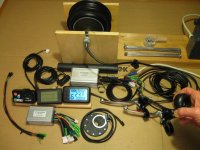
Here you see that the motor has reached a no-load speed of 23.9 mph which by my calculations (23.9 * 336 / 26) equals 309 rpm, just what I ordered. I really like the LCD display - it is perfectly crisp and clear with a nice backlight (much better that what the photo shows) and well laid out.
The two sets of 18 spokes supplied with the kit are approx. 202mm and 208mm long, so I had to scratch my head a bit and head over to Edd (http://lenni.info/edd/) to figure out how I was going to build my wheel. Turned out that I had to do a 0 cross on the freewheel side and a 1 cross on the other side. A bit odd but seems strong enough.
Then I discovered that the dropout spacing was 130mm instead of 135mm. I will show you what I did in my next post.
Last week the kit was shipped in the wee hours of Wednesday morning and arrived at my doorstep on Friday afternoon, a total of 2 1/2 days! Turned out JCEX handed the package over to Fedex Express in China upon which it was flown directly to Seattle and then loaded onto a Fedex truck heading north. The components were packed securely so that nothing was damaged. This is what I received (click to enlarge):
View attachment 1
Yonggang supplied the samples shown in the lower left - 2 different display units and a regular controller.
I have the kit hooked up on my kitchen table test bench, powered by my Ultramotor Europa 36V battery, and undergoing initial testing:

Here you see that the motor has reached a no-load speed of 23.9 mph which by my calculations (23.9 * 336 / 26) equals 309 rpm, just what I ordered. I really like the LCD display - it is perfectly crisp and clear with a nice backlight (much better that what the photo shows) and well laid out.
The two sets of 18 spokes supplied with the kit are approx. 202mm and 208mm long, so I had to scratch my head a bit and head over to Edd (http://lenni.info/edd/) to figure out how I was going to build my wheel. Turned out that I had to do a 0 cross on the freewheel side and a 1 cross on the other side. A bit odd but seems strong enough.
Then I discovered that the dropout spacing was 130mm instead of 135mm. I will show you what I did in my next post.


